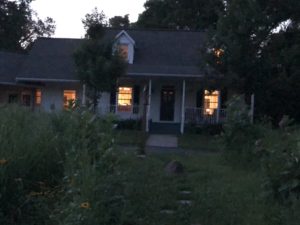The subtleties of walking a labyrinth in fresh snow or in the dark have not been lost on me. Muscle memory, night vision, and simple observation help navigate the terrain when obvious landmarks are obscure.

Muscle memory helps find the path in the dark.
Before the snow fell, when I walk the labyrinth in the dark, the memory of the path, familiarity with the number of steps to a turn, and the various plant heights help me navigate. The funny little statues and boulders along the way form the boundaries. Lights from passing cars not only illuminate the path briefly and also wreck night vision. So, counting steps and simply being aware of where I am on the labyrinth help keep me on the path.
With snow on the ground, the snowshoes make terrific “pat down” equipment and after a few times walking is easy. So, until a new snow, I can just wear boots. Stay on the beaten path or find myself “post-holing” through deep snow.
The brilliance of a sunny day can be confusing, so after a fresh snowfall, I look for the burned stems of plants and the slight depression of past walks as guides. And, how the drifted snow reveals a different texture is fascinating.
Odd marks in the snow capture my attention. Little holes that appear from nowhere, then tiny tracks of a rodent, then another little hole where it dropped back in the security and relative warmth of the snow tunnels.
The fate of the incautious rodent is evident where tracks suddenly disappear with telltale feather strokes on the snow. Whoooo’s for lunch?
Walking the labyrinth in winter brings its own rewards.


I love the simplicity of seeing the tracks in the fresh fallen snow. I am searching for the beauty in it, but it is wearing on me.
I appreciate your support. M~